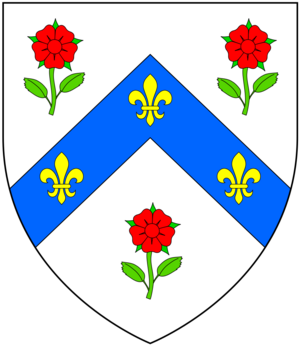Anthony Cope (author) facts for kids
Sir Anthony Cope (born around 1486 – died January 5, 1551) was an English author. He lived at Hanwell, a place near Banbury.
Contents
Who Was Sir Anthony Cope?
Sir Anthony Cope was the younger son of William Cope (who lived from about 1440 to 1513). His father was a "Cofferer of the Household" for King Henry VII. This meant he managed the king's money and household expenses.
Sir Anthony's mother was Jane Spencer. She was William Cope's second wife. Jane Spencer was also the sister of Thomas Spencer from Hodnell, Warwickshire. Sir Anthony had a brother named Sir John Cope, who lived at Canons Ashby, Northamptonshire.
Sir Anthony's Journey and Career
Anthony Cope went to Oxford University, but he didn't get a degree. After university, he traveled a lot in Europe, visiting countries like France, Germany, and Italy. During his travels, he visited many universities. He is thought to have written several books at this time, including some translations of famous ancient doctors like Galen and Hippocrates.
When his father passed away in 1513, Anthony was about 26 years old. He inherited the family home, Hanwell Hall, and other properties. He finished building Hanwell Hall, which his father had started. A famous writer named John Leland later described it as a "very pleasant and gallant house."
In 1536, he received land from a dissolved monastery called Brooke Priory in Rutland. He later sold this land and bought more property in Oxfordshire.
Sir Anthony Cope was a good friend of the Parr family. He worked for Queen Catherine Parr, who was King Henry VIII's last wife. He was first her "master of the Queen’s hawks" and then her "principal chamberlain." This meant he helped manage the Queen's household, including paying for her jewels, clothes, and other supplies.
In 1547, King Edward VI made him a knight. That same year, he was chosen to inspect churches in Canterbury and other areas. In 1548, he served as the sheriff for both Oxfordshire and Berkshire.
Family Life
Sir Anthony Cope married Jane Crewes. She was the daughter of Matthew Crewes from Devon. They had a son and a daughter:
- Edward Cope (died 1557): He married Elizabeth Mohun. Their son, also named Sir Anthony Cope, became the 1st Baronet. Another son, Sir Walter Cope, became an important helper for powerful figures like William Cecil, 1st Baron Burghley.
- Anne Cope: She married Sir Kenelm Digby from Drystoke, Rutland.
Death and Burial
Sir Anthony Cope passed away on January 5, 1551. He was buried in the church where he lived. His wife, Jane, outlived him.
Writings
Sir Anthony Cope was known for his books. Here are some of his works:
- The Historie of the two moste noble Capitaines in the Worlde, Anniball and Scipio: This book was published in 1544. It tells the stories of two famous military leaders, Hannibal and Scipio, translated from the writings of Livy and other sources.
- A Godly Meditacion upon XX. select and chosen Psalmes of the Prophet David: This book, published in 1547, contains his thoughts on 20 chosen Psalms from the Bible.
He also wrote some other works that were not published as books, including a short history and a commentary on the first two gospels, which he dedicated to King Edward VI.


